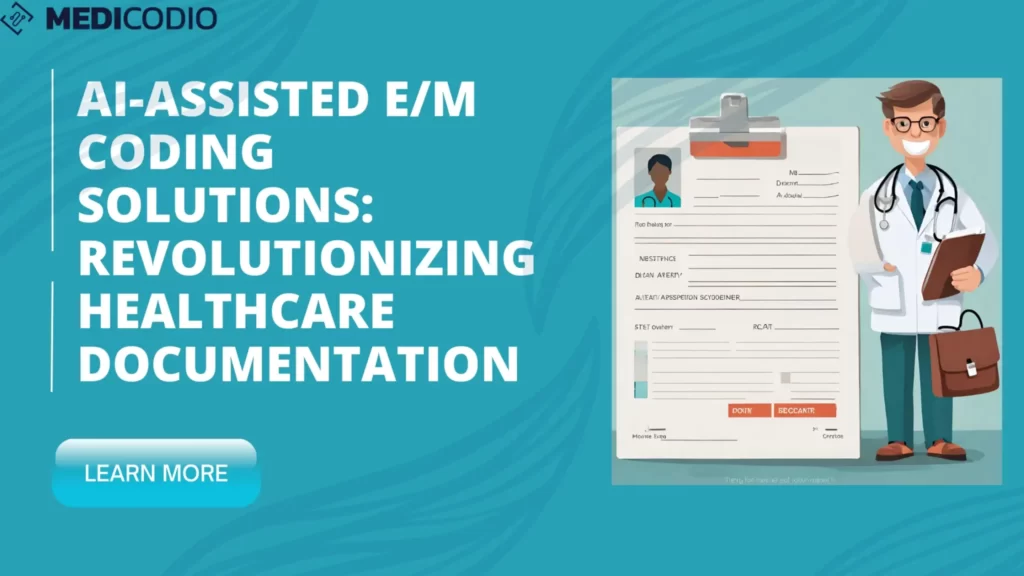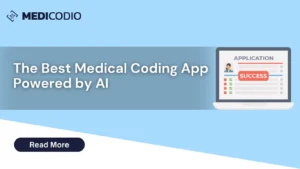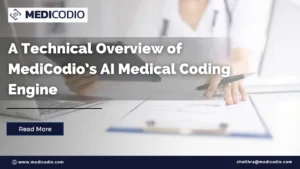In the rapidly evolving healthcare industry, it is crucial to efficiently and accurately document patient encounters. This documentation is essential for insurance claims, quality assessments, and most importantly, providing top-notch patient care. However, the process of Evaluation and Management (E/M) coding, which is the foundation of this documentation, can be complicated, time-consuming, and prone to errors. This is where AI-assisted E/M coding solutions come into play, promising to revolutionize the way healthcare providers handle this vital task.
What are Evaluation and Management (E&M) services?
E&M services refer to various services provided by healthcare providers everything from patient examination to diagnosis of any illnesses, and treatment as needed while the patient is hospitalized.
Accurate documentation and coding of E&M services can be a daunting task as the services provided are primarily cognitive rather than procedural. The purpose of coding an E&M service is to justify the level of care provided to the patient in the form of codes. It’s not just about following the rules when coding medical procedures – coders must also consider the associated reimbursements for each CPT code. This creates a significant challenge because E&M levels are typically chosen based on the provider’s documentation and not on the reimbursement rates. As a result, there is a conflict between the provider’s thought process and the coder’s way of thinking.
What are the 4 levels of E&M services?
The four levels of E/M services are typically defined as follows:
E/M Level 1 – CPT Code Range 99201-99205 (New Patients) and 99211 (Established Patients):
- These represent the lowest level of E/M services.
- They are used for straightforward and brief patient encounters, often involving minor issues.
- Limited documentation and medical decision-making are required.
E/M Level 2 – CPT Code Range 99212-99215 (New Patients) and 99212-99215 (Established Patients):
- These codes are for more intermediate-level encounters.
- Typically, they involve more comprehensive assessments and management of patients.
- There is an increased need for documentation and medical decision-making compared to Level 1.
E/M Level 3 – CPT Code Range 99203 (New Patients) and 99213 (Established Patients):
- These represent a moderate level of E/M services.
- They are used for patient encounters that require an expanded history, a more detailed examination, and a low-to-moderate level of medical decision-making.
- Commonly used for typical office visits for established or new patients with moderately complex medical issues.
E/M Level 4 – CPT Code Range 99204-99205 (New Patients) and 99214-99215 (Established Patients):
- These codes are for high-level E/M services.
- They are used for comprehensive patient encounters with a detailed history, comprehensive examination, and a moderate-to-high level of medical decision-making.
- Typically applied for patients with complex medical conditions or when more time and resources are expended during the visit.
In addition to these four levels, there is also a separate category for critical care E/M services (CPT codes 99291-99292), which are used to describe the management of critically ill patients in settings like the intensive care unit (ICU).
It’s important to note that the choice of E/M level depends on the complexity and comprehensiveness of the patient encounter, including factors like the patient’s medical history, the extent of the physical examination, and the complexity of the medical decision-making involved. Accurate coding is crucial for appropriate reimbursement and proper documentation of patient care. Medical coders and healthcare providers must adhere to guidelines and documentation requirements when selecting the appropriate E/M level.

The Challenges of Traditional E/M Coding
E/M coding is critical for insurance claims, but it’s not without its challenges.
Medical coders who work with Evaluation and Management (E&M) services face several unique challenges due to the complex nature of inpatient care. E&M services involve the coding and documentation of patient encounters within a hospital or other inpatient healthcare facility. Here are some of the challenges they may encounter:
- Complexity of Inpatient Care: Inpatient care often involves patients with multiple, severe medical conditions. Coders must accurately reflect the complexity of the patient’s condition and the level of care provided.
- Volume of Documentation: Inpatient records can be extensive, with numerous progress notes, diagnostic tests, consultations, and treatment plans. Coders must sift through this extensive documentation to extract relevant information for coding.
- Frequent Changes in Patient Status: Patients’ conditions can change rapidly in the inpatient setting. Coders must ensure that codes reflect the evolving medical status and level of care provided during the hospital stay.
- Coding Specificity: Inpatient coding requires a high level of specificity to capture the severity and complexity of a patient’s condition. This involves assigning the correct ICD-10 diagnosis codes and CPT procedure codes.
- Compliance and Regulations: Inpatient coding must comply with various coding guidelines, such as those set by the American Health Information Management Association (AHIMA) and the American Hospital Association (AHA). Coders must stay current with these regulations to ensure accurate coding.
- DRG (Diagnosis-Related Group) Coding: Inpatient coders often need to assign DRG codes, which impact reimbursement. Accurate DRG assignment is critical for hospitals to receive appropriate reimbursement for the services provided.
- Interdisciplinary Collaboration: Inpatient coders must collaborate with various healthcare professionals, including physicians, nurses, and other staff, to obtain necessary information and clarification on documentation.
- Time Sensitivity: Inpatient coding often needs to be completed quickly to facilitate timely billing and ensure that healthcare facilities receive timely reimbursement.
- Training and Education: Coders must undergo continuous training and education to stay current with evolving medical practices and coding guidelines.
- Audit and Compliance Challenges: Inpatient coding is subject to audits and reviews, both internal and external. Ensuring coding accuracy and compliance is vital to avoid legal and financial repercussions.
- Technology and Electronic Health Records (EHRs): The transition to electronic health records presents its own set of challenges, as coders must navigate EHR systems to access patient information and documentation.
- Coding for Complications and Comorbidities (CC/MCC): Identifying and coding for complications and comorbidities accurately is crucial as they can impact reimbursement and the overall clinical picture of the patient.
- Code Changes and Updates: Keeping up with annual updates to ICD-10 and CPT codes is a constant challenge. Coders must adapt to these changes to maintain coding accuracy.
In summary, medical coders working with inpatient E&M services face a demanding and ever-evolving role. Their work is crucial for accurate patient records, reimbursement, and overall healthcare quality, making it essential for them to continually update their knowledge and adapt to changes in healthcare practices and regulations.
The Rise of AI-assisted E/M Coding Solutions
With the advancement of artificial intelligence, a new era in E/M coding has arrived. AI-assisted E/M coding solutions leverage machine learning algorithms to automate and streamline the coding process.
How AI Works in Medical Coding
AI algorithms are trained on vast datasets of medical records, learning to recognize patterns and nuances in healthcare documentation. They can quickly analyze patient notes, diagnoses, and procedures to suggest the most appropriate E/M codes.
Benefits of AI-assisted E/M Coding Solutions
Improved Accuracy and Efficiency
AI can significantly reduce coding errors, leading to more accurate claims submissions. This, in turn, results in quicker reimbursements and reduced claim denials. Healthcare providers can focus on delivering care instead of dealing with billing issues.
The Impact on Healthcare Providers
The implementation of AI-assisted E/M coding solutions has a profound impact on healthcare providers.
Enhanced Productivity
By automating the coding process, AI frees up valuable time for healthcare professionals. This time can be redirected toward patient care, research, or other essential tasks, improving overall productivity.
Reduction of Coding Errors
AI solutions minimize the risk of coding errors, ensuring that the claims submitted are accurate and consistent. This translates to fewer audits and compliance issues.
Implementing AI in E/M Coding
The adoption of AI in E/M coding requires a well-planned approach.
Integrating AI Systems
Healthcare facilities need to integrate AI-assisted E/M coding systems into their existing electronic health records (EHR) systems. This seamless integration is vital for real-time coding suggestions.
Training and Adaptation
Medical coders and staff should receive training to work alongside AI systems. This collaborative effort ensures a smooth transition and optimal results.
AI in Healthcare Beyond E/M Coding
AI’s potential extends beyond E/M coding.
AI can assist in diagnosing diseases, predicting patient outcomes, and personalizing treatment plans, ultimately leading to better patient care and outcomes.
Conclusion
AI-assisted E/M coding solutions mark a significant leap forward in healthcare documentation. They promise greater accuracy, efficiency, and reduced burden on healthcare providers. As AI continues to evolve, its potential for transforming healthcare remains boundless.
Try an AI-powered medical coding solution now and simplify your E/M services.
For in-depth E/M guidelines: Click here!





